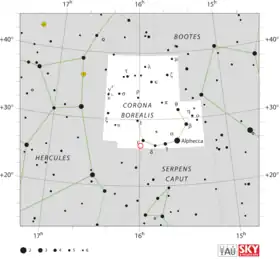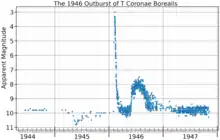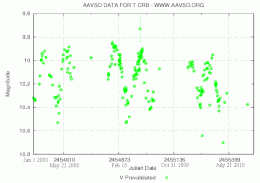 | |
| Observation data Epoch J2000 Equinox J2000 | |
|---|---|
| Constellation | Corona Borealis |
| Right ascension | 15h 59m 30.1622s[1] |
| Declination | 25° 55′ 12.613″[1] |
| Apparent magnitude (V) | 2.0–10.8[2] |
| Characteristics | |
| Evolutionary stage | Red giant + white dwarf |
| Spectral type | M3III+p[3] |
| Variable type | recurrent nova[2] |
| Astrometry | |
| Radial velocity (Rv) | −27.79[4] km/s |
| Proper motion (μ) | RA: −4.220[5] mas/yr Dec.: 12.364[5] mas/yr |
| Parallax (π) | 1.2127 ± 0.0488 mas[5] |
| Distance | 806+34 −30[6] pc |
| Orbit | |
| Period (P) | 227.8 d[7] |
| Semi-major axis (a) | 0.54 AU[6] |
| Eccentricity (e) | 0.0[7] |
| Inclination (i) | 67[8]° |
| Details | |
| Red giant | |
| Mass | 1.12[6] M☉ |
| Radius | 75[8] R☉ |
| Luminosity | 655[9] L☉ |
| Surface gravity (log g) | 2.0[10] cgs |
| Temperature | 3,600[10] K |
| White dwarf | |
| Mass | 1.37[6] M☉ |
| Luminosity | ~100[8] L☉ |
| Other designations | |
| Database references | |
| SIMBAD | data |
T Coronae Borealis (T CrB), is a recurring nova in the constellation Corona Borealis. It was first discovered in outburst in 1866 by John Birmingham,[11] although it had been observed earlier as a 10th magnitude star.[12]
Description

T CrB normally has a magnitude of about 10, which is near the limit of typical binoculars. It has been seen to outburst twice, reaching magnitude 2.0 on May 12, 1866 and magnitude 3.0 on February 9, 1946,[13] although a more recent paper shows the 1866 outburst with a possible peak range of magnitude 2.5 ± 0.5.[14] Even when at peak magnitude of 2.5, this recurrent nova is dimmer than about 120 stars in the night sky.[15] It is sometimes nicknamed the Blaze Star.[16]
T CrB is a binary system containing a large cool component and a smaller hot component. The cool component is a red giant which is transferring material to the hot component. The hot component is a white dwarf surrounded by an accretion disc, all hidden inside a dense cloud of material from the red giant. When the system is quiescent, the red giant dominates the visible light output and the system appears as an M3 giant. The hot component contributes some emission and dominates the ultraviolet output. During outbursts, the transfer of material to the hot component increases greatly, the hot component expands, and the luminosity of the system increases.[6][8][17] [18]

The two components of the system orbit each other every 228 days. The orbit is almost circular and is inclined at an angle of 67°. The stars are separated by 0.54 AU.[6]
2016-present activity
On 20 April 2016, the Sky and Telescope website reported a sustained brightening since February 2015 from magnitude 10.5 to about 9.2. A similar event was reported in 1938, shortly before the 1946 outburst.[19] By June 2018, the star had dimmed slightly but still remained at an unusually high level of activity. Since then, according to observations sent to the AAVSO, the star has hovered around magnitude 10.0.
References
- 1 2 Gaia Collaboration; et al. (November 2016). "Gaia Data Release 1. Summary of the astrometric, photometric, and survey properties". Astronomy & Astrophysics. 595: 23. arXiv:1609.04172. Bibcode:2016A&A...595A...2G. doi:10.1051/0004-6361/201629512. S2CID 1828208. A2.
- 1 2 Samus, N. N.; Durlevich, O. V.; et al. (2009). "VizieR Online Data Catalog: General Catalogue of Variable Stars (Samus+ 2007-2013)". VizieR On-line Data Catalog: B/GCVS. Originally Published in: 2009yCat....102025S. 1. Bibcode:2009yCat....102025S.
- ↑ Pourbaix, D.; Tokovinin, A. A.; Batten, A. H.; Fekel, F. C.; Hartkopf, W. I.; Levato, H.; Morrell, N. I.; Torres, G.; Udry, S. (2004). "SB9: The ninth catalogue of spectroscopic binary orbits". Astronomy and Astrophysics. 424 (2): 727–732. arXiv:astro-ph/0406573. Bibcode:2004A&A...424..727P. doi:10.1051/0004-6361:20041213. S2CID 119387088.
- 1 2 3 Brown, A. G. A.; et al. (Gaia collaboration) (August 2018). "Gaia Data Release 2: Summary of the contents and survey properties". Astronomy & Astrophysics. 616. A1. arXiv:1804.09365. Bibcode:2018A&A...616A...1G. doi:10.1051/0004-6361/201833051. Gaia DR2 record for this source at VizieR.
- 1 2 3 4 5 6 Linford, Justin D.; Chomiuk, Laura; Sokoloski, Jennifer L.; Weston, Jennifer H. S.; Van Der Horst, Alexander J.; Mukai, Koji; Barrett, Paul; Mioduszewski, Amy J.; Rupen, Michael (2019). "T CRB: Radio Observations during the 2016-2017 "Super-active" State". The Astrophysical Journal. 884 (1): 8. arXiv:1909.13858. Bibcode:2019ApJ...884....8L. doi:10.3847/1538-4357/ab3c62. S2CID 203593955.
- 1 2 Fekel, Francis C.; Joyce, Richard R.; Hinkle, Kenneth H.; Skrutskie, Michael F. (2000). "Infrared Spectroscopy of Symbiotic Stars. I. Orbits for Well-Known S-Type Systems". The Astronomical Journal. 119 (3): 1375. Bibcode:2000AJ....119.1375F. doi:10.1086/301260.
- 1 2 3 4 Stanishev, V.; Zamanov, R.; Tomov, N.; Marziani, P. (2004). "Hα variability of the recurrent nova T Coronae Borealis". Astronomy and Astrophysics. 415 (2): 609–616. arXiv:astro-ph/0311309. Bibcode:2004A&A...415..609S. doi:10.1051/0004-6361:20034623. S2CID 3000175.
- ↑ Schaefer, Bradley E. (2009). "Orbital Periods for Three Recurrent Novae". The Astrophysical Journal. 697 (1): 721–729. arXiv:0903.1349. Bibcode:2009ApJ...697..721S. doi:10.1088/0004-637X/697/1/721. S2CID 16087253.
- 1 2 Wallerstein, George; Harrison, Tanya; Munari, Ulisse; Vanture, Andrew (2008). "The Metallicity and Lithium Abundances of the Recurring Novae T CrB and RS Oph". Publications of the Astronomical Society of the Pacific. 120 (867): 492. Bibcode:2008PASP..120..492W. doi:10.1086/587965. S2CID 106406607.
- ↑ Pettit, Edison (1946). "The Light-Curves of T Coronae Borealis". Publications of the Astronomical Society of the Pacific. 58 (341): 153. Bibcode:1946PASP...58..153P. doi:10.1086/125797.
- ↑ Barnard, E. E. (1907). "Nova T Coronae of 1866". Astrophysical Journal. 25: 279. Bibcode:1907ApJ....25..279B. doi:10.1086/141446.
- ↑ Sanford, Roscoe F. (1949). "High-Dispersion Spectrograms of T Coronae Borealis". Astrophysical Journal. 109: 81. Bibcode:1949ApJ...109...81S. doi:10.1086/145106.
- ↑ Schaefer, Bradley E. (2010). "Comprehensive Photometric Histories of All Known Galactic Recurrent Novae". The Astrophysical Journal Supplement Series. 187 (2): 275–373. arXiv:0912.4426. Bibcode:2010ApJS..187..275S. doi:10.1088/0067-0049/187/2/275. S2CID 119294221.
- ↑ "Vmag<2.5". SIMBAD Astronomical Database. Retrieved 2010-06-25.
- ↑ A Digital Spectral Classification Atlas, R. O. Gray, 34. Unusual Stellar Spectra III: two emission-line stars
- ↑ Iłkiewicz, Krystian; Mikołajewska, Joanna; Stoyanov, Kiril; Manousakis, Antonios; Miszalski, Brent (2016). "Active phases and flickering of a symbiotic recurrent nova T CrB". Monthly Notices of the Royal Astronomical Society. 462 (3): 2695. arXiv:1607.06804. Bibcode:2016MNRAS.462.2695I. doi:10.1093/mnras/stw1837. S2CID 119104759.
- ↑ Luna, GJM; Mukai, K.; Sokoloski, J. L.; Nelson, T.; Kuin, P.; Segreto, A.; Cusumano, G.; Jaque Arancibia, M.; Nuñez, N. E. (2018). "Dramatic change in the boundary layer in the symbiotic recurrent nova T Coronae Borealis". Astronomy and Astrophysics. 619 (1): 61. arXiv:1807.01304. Bibcode:2018A&A...619A..61L. doi:10.1051/0004-6361/201833747. S2CID 119078482.
- ↑ "Is T CrB About to Blow its Top?". Sky & Telescope website. 20 April 2016. Retrieved 2017-08-06.
Further reading
- Wallerstein, George; Tanya Harrison; Ulisse Munari; Andrew Vanture (11 May 2008). "The Metallicity and Lithium Abundances of the Recurring Novae T CrB and RS Oph". Publications of the Astronomical Society of the Pacific. 120 (867): 492–497. Bibcode:2008PASP..120..492W. doi:10.1086/587965. S2CID 106406607.
- R and T Coronae Borealis: Two Stellar Opposites Archived 2012-04-06 at the Wayback Machine at Sky & Telescope
External links
- http://www.daviddarling.info/encyclopedia/B/Blaze_Star.html
- AAVSO: Quick Look View of AAVSO Observations (get recent magnitude estimates for T CrB)